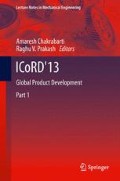Abstract
No one trajectory leads to becoming a design researcher. This paper is an interim overview of one case of a designer who became a design researcher. Through concerns derived from experience as a designer and a design teacher, and learning from observations of children designing, some fundamental questions were formulated under the common theme of design cognition. Two major lines of research were undertaken over the years: first, modeling and measuring design reasoning. This is done with linkography, which is a system for the notation and analysis of design activities based on protocols. With linkography light can be shed on the structure of the design process and its quality, especially its creativity. Second, visual thinking in design and primarily the generation of sketches and the use of visual stimuli are investigated. Experimental work confirms the importance of visual thinking in designing.
Access this chapter
Tax calculation will be finalised at checkout
Purchases are for personal use only
References
Goldschmidt G (1994) Development in architectural designing. In: Franklin MB, Kaplan B (eds) Development and the arts: critical aspects. NJ Lawrence Erlbaum Associates, Hillsdale, pp 79–112
Arnheim R (1983) Design thinking. University of California Press, Berkeley
Goldschmidt G (1983) Doing design, making architecture. J Architect Educ 37(1):8–13
Goldschmidt G (1988) Interpretation: its role in architectural designing. Des Stud 9(4):235–245
Goldschmidt G (1989) Problem representation versus domain of solution in architectural design teaching. J Architect Plann Res 6(3):204–215
Cross N (1984) Developments in design methodology. Wiley, Chichester
Lawson B (1980/2005) How designers think: the design process demystified. Butterworth/Architectural Press, Oxford
Akin Ö (1978) How do architects design. In: Latombe JC (ed) Artificial intelligence and pattern recognition in computer aided design. IFIP. North Holland Publishing, Amsterdam, pp 65–104
Gero JS, Maher ML (1990) Theoretical requirements for creative design by analogy. In: Fitzhorn P (ed) Proceedings of the 1st international workshop on formal methods in engineering design, manufacturing and assembly, Colorado State University, Fort Collins, pp 19–27
Schön DA (1983) The reflective practitioner. Basic Books, New York
Ericsson KA, Simon HA (1984/1993) Protocol analysis: verbal reports as data. MIT Press, Cambridge, MA
van Someren MW, Barnard YF, Sandberg JA (1994) The think aloud method: a practical guide to modeling cognitive processes. Academic, London
Goldschmidt G (1990) Linkography: assessing design productivity. In: Trappl R (ed) Proceedings of the 10th European meeting on cybernetics and systems research. World Scientific, Singapore, pp 291–298
Goldschmidt G (Forthcoming) Linkography: unfolding the design process. MIT Press, Cambridge, MA
Suwa M, Tversky B (1997) What do architects and students perceive in their design sketches? A protocol analysis. Des Stud 18(4):385–403
Kan JWT, Gero JS (2008) Acquiring information from linkography in protocol studies of designing. Des Stud 29(4):315–337
Kvan T, Gao S (2006) A comparative study of problem framing in multiple settings. In: Gero JS (ed) Design computing and cognition’06. Springer, Dordrecht, pp 245–263
van der Lugt R (2003) Relating the quality of the idea generation process to the quality of the resulting design ideas. In: Folkeson A, Gralén K, Norell N, Sellgren U (eds) Proceedings of 14th international conference on engineering design, Design Society, Stockholm (CD: no page numbers)
Boden MA (1994) What is creativity? In: Boden MA (ed) Dimensions of creativity. MIT Press, Cambridge, pp 75–117
Plucker JA, Renzulli JS (1999) Psychometric approaches to the study of human creativity. In: Sternberg R (ed) Handbook of creativity. Cambridge University Press, Cambridge, pp 35–61
Gabora L (2010) Revenge of the ‘neurds’: characterizing creative thought in terms of the structure and dynamics of memory. Creativity Res J 22(1):1–13
Dong A (2007) The enactment f design through language. Des Stud 28(1):5–21
Ferguson ES (1992) Engineering and the mind’s eye. MIT Press, Cambridge
Goldschmidt G (1991) The dialectics of sketching. Creativity Res J 4(2):123–143
Casakin H, Goldschmidt G (1999) Expertise and the use of analogy and visual displays: implications for design education. Des Stud 20(2):153–175
Goldschmidt G (2012) A micro view of design reasoning: two-way shifts between embodiment and rationale. In: Carroll JM (ed) Creativity and rationale in design: enhancing human experience by design. Springer, London, pp 41–55
Author information
Authors and Affiliations
Corresponding author
Editor information
Editors and Affiliations
Rights and permissions
Copyright information
© 2013 Springer India
About this paper
Cite this paper
Goldschmidt, G. (2013). How I Became a Design Researcher. In: Chakrabarti, A., Prakash, R. (eds) ICoRD'13. Lecture Notes in Mechanical Engineering. Springer, India. https://doi.org/10.1007/978-81-322-1050-4_1
Download citation
DOI: https://doi.org/10.1007/978-81-322-1050-4_1
Published:
Publisher Name: Springer, India
Print ISBN: 978-81-322-1049-8
Online ISBN: 978-81-322-1050-4
eBook Packages: EngineeringEngineering (R0)

